The reasons, procedures, and tools for draining a fire sprinkler system
Without water, most fire protection systems are empty pipes fastened inside walls and ceilings. We’ve routinely emphasized the importance of supplying adequate water to your building’s fire sprinkler and standpipe systems. But today, we explore the opposite goal: Why would a system need to be drained?
In this article, we’ll discuss the four primary reasons why you may need to drain a fire sprinkler system. Then we’ll dive deep into the different types of drain valves and NFPA’s perspective on the placement and usage of those valves, and conclude with some helpful advice about the signs and decals needed to identify drain valves.
Not what you’re looking for? If you need a common drain valve, check out our selection of ball valves and test and drain valves.
Fire sprinkler system overview
Before we dive into draining a fire sprinkler system, it is crucial to understand where these drains fit into the overall type of system you may have in your building. It is also important to know where the water to be drained is held before and after the system is activated.
As a quick refresher, there are four basic types of fire sprinkler systems. Each has its own way of doing similar jobs; usually controlling but sometimes extinguishing a fire threat.
- Wet System: A wet fire sprinkler system always has pressured water in the pipes and a sprinkler activates when it is triggered by heat.
- Dry System: A dry fire sprinkler system is filled with compressed air or nitrogen and only filled with water once a sprinkler is triggered.
- Preaction System: A preaction fire sprinkler system essentially begins like a dry system; once an event happens, water fills the system. Non-interlock systems activate after the detection system is triggered or a sprinkler activates; single-interlock systems activate when the detection system activates; double-interlock systems spring into action when the sprinkler and the detection system activate.
- Deluge System: A deluge fire sprinkler system is always open, and the water is held back until an alarm is triggered.
If you’d like a broad overview of fire sprinkler systems, please read QRFS blog #75 — Fire Sprinkler System Types.
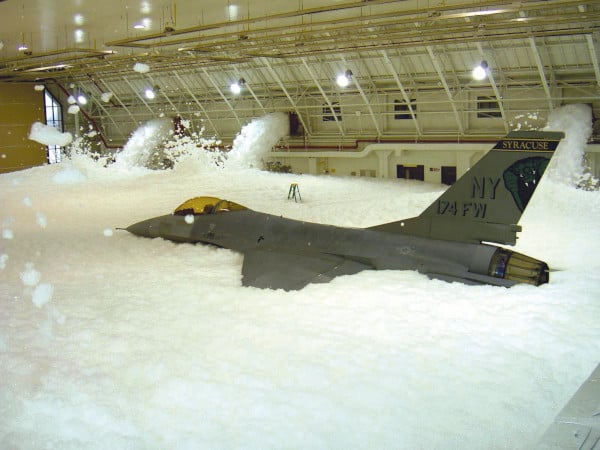
Now that we have refamiliarized ourselves with the different types of systems and how systems hold and deliver water (or water-based extinguishment), let’s consider why you would need to drain a fire sprinkler system.
Cautionary Note: We do NOT suggest or condone draining a sprinkler system by anyone who is not qualified or without proper authorization from your local authority having jurisdiction. Always consult a qualified pro and the AHJ BEFORE modifying your fire sprinkler system in any way. Failure to do so could cause injury, damage to your system, or damage to your property. Only a licensed and insured fire sprinkler professional should drain a fire sprinkler system.
Why would a fire sprinkler system need to be drained?
There are several events that could warrant the need for a fire sprinkler system to be drained, including but not limited to:
- Repairs – Repairs need to be made in numerous instances, such as when a fire protection system is not properly maintained and there are signs of corrosion, the system was damaged after a natural disaster, or an act of vandalism occurs. You would need to drain the fire sprinkler system before beginning repairs.
- Restoring an activated dry or preaction system – These systems do not have water in the pipes like a wet pipe system. Compressed air or nitrogen fills the pipes until the fire sprinkler system is activated. Once activated, the system needs to be drained to restore it to normal operation.
- Extending an existing system – When a building has an addition or you are otherwise extending an existing system to cover more area, you may need to drain the fire protection system before work begins.
If you’d like more info on when a system should be drained, check out this PDF covering wet systems from insurer AIG: Procedures for Draining Sprinkler Systems.
Each fire protection system will need to be drained at some point. And NFPA 13: Standard for the Installation of Sprinkler Systems specifies that all systems must have the ability to be drained when needed.
From the 2022 edition of NFPA 13
16.10.1* General. All sprinkler pipe and fittings shall be installed so that the system can be drained.
Here are the main components that enable system drainage:
The fire sprinkler main drain
The main drain is the primary means of flushing water from the system. The size of the main drain is in proportion to the size of the riser.
From the 2022 edition of NFPA 13
Ideally, the entire system should be arranged so that all water can be drained through the main drain. If this cannot be accomplished, auxiliary drainage facilities in accordance with 16.10.5 and sectional drainage in accordance with 16.10.4.3 need to be sized and arranged with consideration for the type of system and the volume of trapped piping.
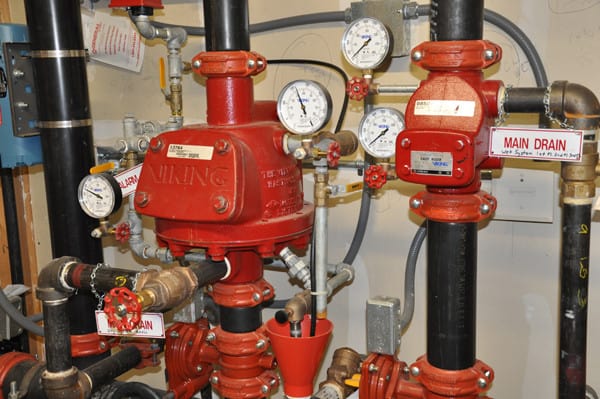
When is the main drain used and why?
The main drain is the central point of discharge used to flush water from the system. All piping within the system, “where practicable,” is required to flow to the main drain. If the fire protection system needs repair, retrofit, or a test of the incoming flow of water, the main drain valve is opened to evacuate the system of the water it contains.
Where is the main drain located?
The main drain is located at the fire sprinkler system riser. It’s set up to discharge water outside and away from the building or to a connection that can handle the flow of the drain. Given that the entire system may need to be drained, the amount of water will vary based on the size of the system. This can range from just a few gallons of leftover water for a dry system to way more in a wet system.
Think about filling a five-gallon bucket; one is not going to help you flush a full wet system. If the discharge were allowed inside the building to another connection like a janitorial sink, it might not be able to handle the flow, which is usually around 100 gallons per minute. You could have a flooding incident on your hands. Therefore, it is preferable that all connections discharge outside of the building.
The discharge drain connections are dependent on the riser size. According to NFPA 13, risers that are 2” should use a 3/4″ or larger drain connection. If the riser is 2 ½” or 3”, then the drain connection must be at least 1 ¼ inches. If it’s 4”, then the drain connection should be 2 inches or larger. This connection leads to the main drain valve. From the drain valve, another connection leads away from the riser and out of the system to another connection or out of the building into the atmosphere.
If the main drain connection leads out of the building, it should have protection from the elements to prevent clogging or freezing. A turned-down elbow will help prevent intentional and accidental clogging. At least 4 feet of exposed piping is required to be in a heated area before the pipe extends beyond the exterior wall.
All four fire sprinkler types are required to have a main drain. While the method of drainage is different for each, they all serve the same purpose; to flush and reset the system for future use.
What kind of valve and signage is required for a fire sprinkler system’s main drain?
NFPA doesn’t specify a particular type of valve for use as a main drain. However, several types of valves are suitable, including an angle valve, a ball valve, or a test and drain valve.
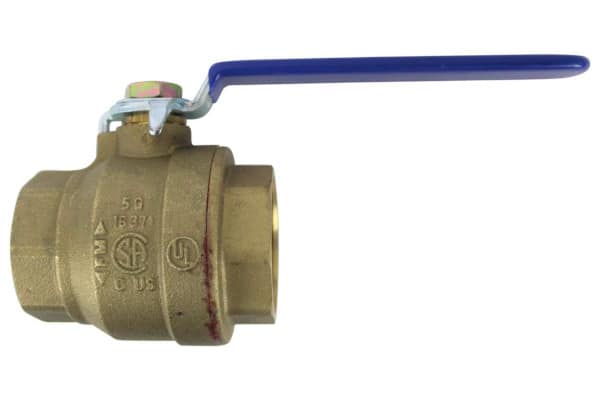
In accordance with NFPA 13 section 6.6.4, all valves used in testing and draining should be approved by the authority having jurisdiction. While third-party listings are available for trim and drain valves, including test and drain valves, those listings aren’t required for main drain valves under the NFPA standard.
Main drains are required to be permanently marked with weatherproof metal or plastic identification signs (16.9.11.1). The signs are hung from the pipe below the valve they are marking. They must be secured with a non-corrosive wire or chain to prevent them from falling off. There also must be a separate means to indicate that the valve is open or closed.

Fire sprinkler auxiliary drains
An auxiliary drain is designed to allow drainage when the main drain valve is insufficient and results in water being trapped within the system. The valve size relative to the pipe used is specified by NFPA. And how many drains a system contains will depend on how big the system is and how much water can be trapped.
From the 2022 edition of NFPA 13
16.10.5.1 Auxiliary drains shall be provided where a change in piping direction prevents drainage of system piping through the main drain valve.
When is an auxiliary drain used and why?
Auxiliary drains are used during or after a system flush when the main drain leaves water in the system. Any time there is a change of direction of the pipe in the system, there is a danger of water lingering in that area. The auxiliary drains help complement and finish the job of the main drain.
Where is an auxiliary drain located?
Auxiliary drains are located at each point where the pipe changes direction. These drains should be accessible, especially those that are in areas subject to freezing. When the pipe changes direction, there is a “T” connection instead of an elbow. One part of the change in direction flows to the remainder of the system. The other direction flows to the auxiliary drain valve.
All fire sprinkler system types require auxiliary drains when the danger of trapped water is present.
What valve size and signage are required for a fire sprinkler system’s auxiliary drain?
The size of the valve will depend on the amount of potential water trapped in the piping and if the piping is subject to freezing conditions. NFPA gets very specific in its valve size prescriptions by sprinkler system type:
- Wet pipe systems and preaction systems with no freezing conditions: If trapped piping is more than 50 gallons, the valve should be no less than a 1”; if between 5 and 50 gallons, a ¾” valve should be used in addition to a nipple with a cap or plug. And if less than 5 gallons are trapped, then a nipple with a cap or plug that is not less than ½ inch can be used. If trapped piping is less than 5 gallons, the auxiliary drain can be omitted if the trapped water can be drained by disconnecting a sprinkler head, or where easily-separated sections are used.
- Dry pipe systems and preaction systems with freezing conditions: If trapped piping is between 5 and 50 gallons, two 1” valves should be used, separated by a 2”x 12” condensate nipple. If it is less than 5 gallons, a valve not smaller than ½” and a plug or a nipple and cap should be used.
Auxiliary drains are required to have permanently marked waterproof metal or plastic identification signs (16.9.11.1). The signs must be secured to the pipe and hung below the valve with non-corrosive wire or chain to prevent the sign from falling off. There also must be a means to indicate that the valve is open or closed.
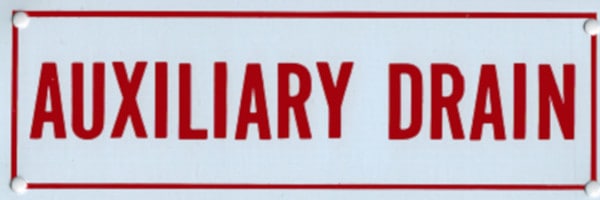
Additional signage should be placed near the control valve that indicates the number of auxiliary drains and the location of each drain.
The fire sprinkler test drain
So far, we have looked at situations draining the entire system. But what if that isn’t necessary? If your goal is to simply test the fire protection system pressure, then you can use a test drain.
From the 2022 edition of NFPA 13
16.10.4.6.1 Main drain test connections shall be provided at locations that will permit flow tests of water supplies and connections.
When is a test drain used and why?
A test drain is used to monitor changes in water flow through the system. While it is not essential to the basic function of a fire protection system, it is beneficial to have when you need to run tests. The size and type of connections are again determined by NFPA.
A drain test is required annually, or any time the water supply is cut off. It will also need to be conducted anytime there is any maintenance done on the system. The system drain valve is opened until pressure stabilizes. Numbers are recorded, and the valve is closed again. The time it takes to pressurize the system also needs to be within certain parameters.
Where is a test drain located?
The main test drain should be placed at a location that will permit the flow test, usually as part of the main drain riser. They can also be found at the end of the system; this allows the ability to check for clogs in the pipe. These drains also need to be placed where the valve can be opened fully.
Most test drains are designed with the wet fire protection system in mind. Their drain function allows the system to be emptied quickly. They can also serve as the main drain, replacing the drain valve. While test drains are primarily designed for wet systems, they can be used on other system types.
What type of valve and signage is required for a fire sprinkler system’s test drain?
A test and drain valve is customary and preferable, but a simple ball valve can be used. The difference is that a test and drain valve is equipped with a sight glass that gives visual confirmation of water flowing through the fire protection system and a testing orifice that simulates a sprinkler head discharge. This enables the test to be done without having to drain the system. If a ball valve is used, then you would need an inspector’s test and sight glass AND to drain the system.
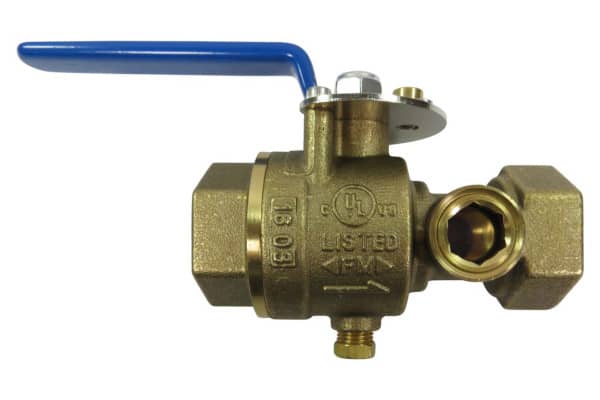
The same requirements for other signage are applicable for test drains in line with NPFA 13 (2022), section 16.9.11. They are required to be permanently marked signs of weather-proof metal or plastic. The signs must be secured to the pipe above the valve they are listing with non-corrosive wire or chain. There also must be a means to indicate that the valve is open or closed.
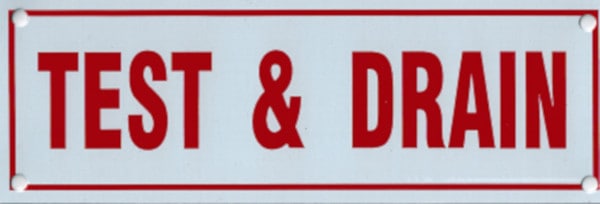
If you’d like to learn more, NFPA 13 and 25 are both valuable resources. So is this FEMA video.
The fire sprinkler sectional valve
We have learned about the different valves for draining an entire system, and we have looked at valves that enable the system to be tested. But what if you have a multi-sectioned building and you only need to repair or test one section? What do you do then? This is where the sectional valve comes in. A sectional valve, also known as a floor valve, is a control valve that isolates specific areas of the fire sprinkler system.
Sectional valves, like all control valves, need supervision. This means they are to be held in a controlled environment that discourages tampering.
From the 2022 edition of NFPA 13
16.10.4.3 Where an interior sectional or floor control valve(s) is provided, it shall be provided with a drain connection having a minimum size as shown in Table 16.10.4.2 to drain that portion of the system controlled by the sectional valve.
When is a sectional valve used and why?
The sectional valve is used when the need for repair or testing exists for only a specific section of pipe. The valve to that section is closed so the test or repair can be performed without having to shut down the entire system. It is also used to test for pressure and leaks within each section, independently from the others.
Where is a sectional valve located?
Sectional valves are located where each new section begins. If you have multiple floors or sections that are protected, then it would be beneficial to begin each branched-off area with a sectional valve. Also in each sectioned area, a separate drain connection is required to enable the isolated area to be drained.
- Wet system sectional valves allow one section to be isolated while the other sections or floors can remain operational and filled with water. Once repairs or tests are completed, the sectional valve can be reopened, and the isolated section is brought back to use.
- Dry, preaction, and deluge system sectional valves are used to isolate an area for maintenance or testing while the remainder of the system continues to be fully functional.
What kind of signage is required to identify a sectional valve?
All sectional valves on a fire sprinkler system should be listed and indicating in accordance with NPFA 13, section 16.9.3. Sectional and floor valves are required to be permanently marked with weatherproof metal or plastic identification signs. The signs must be secured to the pipe and hang below the valve it is listing, with non-corrosive wire or chain. There also must be a means to indicate that the valve is open or closed.
Fire sprinkler trim valves and signs
Now that we know all about the draining of the system, let’s take a look at the components, sometimes called “trim,” that make up these drains and valves and the signs that accompany them. The “trim” on valves is the network of pipes, valves, gauges, and switches comprising a valve assembly.
The trim begins with the valve itself. The size and type of valve will be determined by the size and type of pipe and the pressure of the system.
Trim valves vary between ball valves, butterfly valves, angle valves, globe valves, and more. They often come in kits where the multiple trim items are pre-assembled, such as the three-way valve in the fire sprinkler gauge kit:
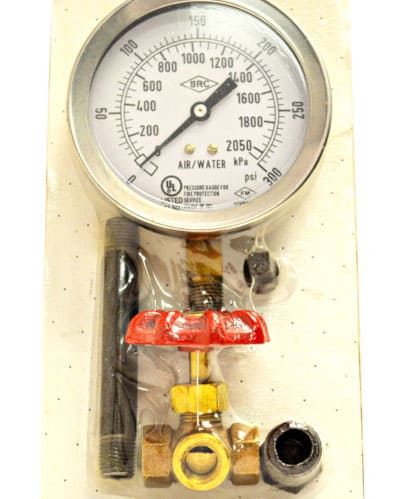
Once the system is designed, the valve is selected and trimmed to fit.
A check valve, common in standpipe and sprinkler systems, can also be part of a fire protection system trim assembly. A check valve allows the flow of water in one direction only; it contains a stopper that prevents backflow in the other direction. This is invaluable when there are more than two water sources, as check valves prevent each water source from becoming contaminated by the other. Look for UL-listed/FM-approved check valves and trim kits that are pre-aggregated.
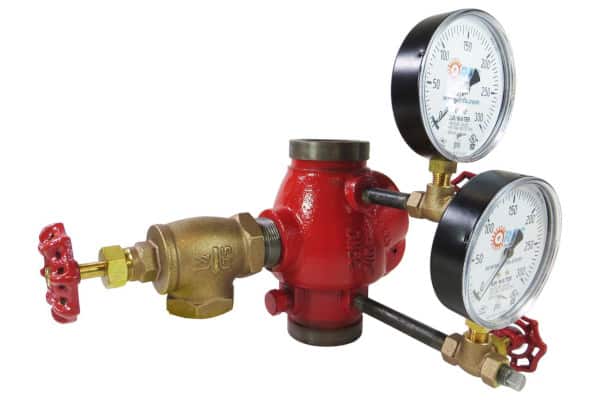
Each fire sprinkler system will have its own set of trim that is used. Since a dry system is filled with compressed gas instead of water, it will require more gauges. NPFA 13, 7.2.1 specifies the different gauges involved.
According to NFPA 13, section 16.9.11, mandatory fire sprinkler system signs connected directly to the valve identify the valve and give specific information. Signs are crucial and shouldn’t be overlooked. Not only do they help building owners maintain and service their system, but they also help first responders quickly familiarize themselves with the system and allow licensed professionals to locate the system’s valves quickly and easily.
Remember, sprinkler system signs must be permanent, able to withstand the elements, and always in view and legible … like these signs.
Every valve we discussed in this article can be found on QRFS.com; we encourage you to check them out. If you have further questions or need a fire sprinkler system component, please call us at 888-361-6662 or contact us here.
This blog was originally posted by Jason Hugo and Maurice Draine at blog.qrfs.com on December 7, 2017, and updated on February 20, 2023. If you found this article useful, check us out on Facebook or Twitter.


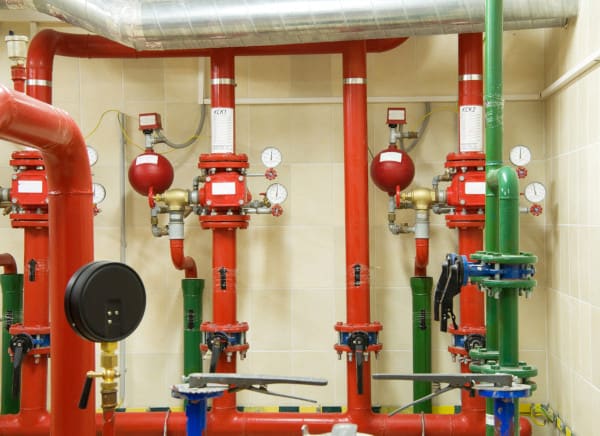
I’m working on an apartment building project in San Diego, Ca., my plumbing inspector won’t let me drain the system directly into the sewer line, even though I have hard piped it into the sewer system.
He wants a 4″ stand pipe with a wet trap. this will use up a large amount of water throughout the year keeping the trap filled with water.
If, I drain the system into the storm water drains via the city gutters I would be in violation
The system only needs to be drained once a year?
Can you possibly give me any advice?
Thanks for your time,
Steven
Steven, thanks for reaching out. For questions like this, we recommend submitting your question through QRFS Ask A Pro. Click the link to submit your question with some information about your building or system, and a fire protection professional will provide a detailed answer based on standards and codes. Our pros include AHJs, contractors, engineers, and code experts with 150+ years of combined experience!
Hi Steven,
The authority is the authority. They can withhold approval if you don’t do what they say so you may be stuck doing what your plumbing inspector says.
Are you sure you would be in violation draining sprinkler water into a storm water drain? Draining to storm water is more common in my experience. Most environmental authorities don’t seem to have a problem with it. If you use steel pipes, the water will be discolored black from iron oxide, which looks contaminated, but it’s not harmful. Sure, it looks disgusting, but iron oxide is not toxic and you could safely drink it (although you wouldn’t just because of the color).
Dear Sirs,
Our company will design a water supply system including a fire sprinkler system for few buildings in an industrial park in Hungary. As there are no rules or any directive for disposal of sprinkler effluent water here, we prefer to drain that into stormwater channel. However, the Authority would be against it. What is the general rule in the USA for disposal of such wastewater? Positive American experience would probably convince the authority persons to accept the undoubtedly cheaper solution.
Thanks,
Zoltán
Zoltán, thanks for reaching out. For code and compliance questions like this, we recommend submitting your question through QRFS Ask A Fire Pro. Click the link to submit your question with some information about your building or system, and a fire protection professional will provide a detailed answer based on standards and codes. Our pros include AHJs, contractors, engineers, and code experts with 150+ years of combined experience!
After a sprinkler event occurs does the dry system automatically recharge the system with air or is there a procedure to achieve this.
George — Yes, steps must be taken to reset the system. At a minimum, for example, the activated sprinklers must be replaced, as the pressurized air or nitrogen will leak out of the hole after the water stops flowing. For a more detailed answer depending on your situation, you can submit a question through QRFS Ask A Fire Pro. Click the link to submit your question with some information about your building or system, and a fire protection professional will provide a detailed answer based on standards and codes. Our pros include AHJs, contractors, engineers, and code experts with 150+ years of combined experience!
After you insure no water coming to you, let it fly. When filling, stuff flow switch and open up control valve. After fully open on control valve, do a main drain test per nfpa 25 to insure all valves are open. Caution is key
in an existing project, some auxiliary drains were missed to be installed. what is the alternative solution to properly drain the system when we have a change in direction ?
Ellie — For code and specific system application questions like this, you should consult with a fire protection ITM professional, or you can try our Ask a Fire Pro service. Click the link to submit your question with some information about your building or system, and a fire protection professional can provide an answer based on standards and codes.
I’m having trouble in the code book(13&25)where to find that “main drains are to be piped out the exterior wall of a bldg. or in a floor drain”.
For code and specific system application questions like this, you can try our Ask a Fire Pro service. Click the link to submit your question with some information about your building or system, and a fire protection professional will provide an answer based on standards and codes. Our pros include AHJs, contractors, engineers, and code experts with 150+ years of combined experience!
If I were you I would pipe it out the exterior wall of the building for Testing purposes in the future..
For regulations how many feet should be around the system for fire code?
Kris — We’re unsure about what you mean by “around the system.” (e.g., feet between what and what?) Please clarify — thanks!
Hes referring to clear distance around fire equipment , space around valves etc for access.
In that case, to our knowledge, ICC codes and NFPA standards don’t specify exact distances but specify the equipment area must be kept clear for ready access. For example:
From the 2024 International Fire Code:
However, local requirements may be more specific, like these typical fire pump and riser room clearance amendments to the IFC from Lynnwood, WA’s 2019 Municipal Code:
So, the original commenter will need to check with their local rules and authority having jurisdiction. Thanks for the (likely and hopefully accurate) clarification, John!
Buenos días
Estoy trabajando en un sistema de diluvio de una planta de tratamiento de crudo. Tengo que colocar drenajes en tuberías secas que van a anillos de tanques de 2000m3 de combustible. Las cañerías horizontales que tenemos tienen una pequeña pendiente pero son de cientos de metros antes de cambiar de dirección hacia arriba a lo que sería la montante.
Es necesario colocar drenajes en la líneas horizontales? O solo debemos colocar los drenajes auxiliar en el punto donde hay cambio de dirección hacia arriba?
Gracias
Cira —
La Sección 16.10.5.1 de la NFPA 13 (edición 2025) especifica que “los drenajes auxiliares son necesarios para las tuberías con sifón” cuando “un cambio en la dirección de la tubería impide el drenaje del sistema a través de la válvula principal de drenaje”.
También especifica que “el tipo de drenaje auxiliar, su tamaño y su disposición dependen del tipo de sistema, de si la tubería está sujeta a condiciones de congelación y del volumen de la tubería con sifón”.
Desafortunadamente, las secciónes posteriores, basadas en una capacidad mínima de la sección aislada de tubería con sifón, el tipo de sistema y la configuración, no mencionan los sistemas de diluvio. Solo especifican “Drenajes auxiliares para sistemas de tubería húmeda y sistemas de preacción en áreas no sujetas a congelación” o “Drenajes auxiliares para sistemas de tubería seca y sistemas de preacción en áreas sujetas a congelación”.
Por lo tanto, plantea una buena pregunta para la cual no tenemos una respuesta definitiva, salvo que se deben instalar drenajes auxiliares “siempre que un cambio en la dirección de la tubería impida el drenaje de la tubería del sistema a través de la válvula de drenaje principal”. Es una buena pregunta para la NFPA.
¡Gracias por leer!